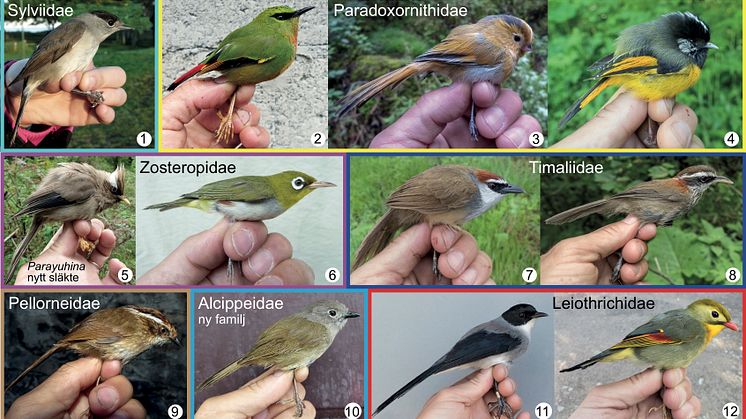
Press release -
Hundreds of babblers’ DNA analysed
Using DNA sequences for 402 of the 452 species of the world’s “babblers”, an international team from China, Sweden, Denmark, Switzerland and the USA have analysed the evolutionary relationships among these species. Many of these species have not previously been studied using genetic methods, and this is by far the most comprehensive analysis of this group of birds to date.
This study identified seven main groups of babblers, which were estimated to have started to differentiate c. 18–20 million years ago, during the period known as the Miocene. The authors suggest that all seven main groups should be treated as different families. One of these groups was described as a new family, Alcippeidae, which comprises a single genus (Alcippe) of rather small, mostly grey and brown forest birds from southern Asia. One large family (Sylviidae) was divided into two families (a smaller Sylviidae and a reinstated Paradoxornithidae) , because these were so anciently diverged (19.5 million years ago).
Multiple other, previously unrecognised relationships were revealed, including some that suggested the presence of several currently unrecognised “cryptic species”. One species, the White-collared Yuhina, was found to be so distinctive that it was proposed to be placed in a new genus, Parayuhina.
The babblers are a large group of passerine birds, comprising 452 species. Most of these live in the southern parts of Asia, but many also occur in Africa. Only a few species are found in Europe, including common birds such as the Blackcap, Garden Warbler and Lesser Whitethroat. A single species, the Wrentit, lives in North America.
The babblers inhabit forests and various types of scrubland, from sea level to above the tree limit. In general, they are very secretive, hiding in dense vegetation. The diversity in size (c. 6–155 g), shape and plumage is enormous. Some species are very dull and non-descript, whereas others have amazing colour patterns. Many species are renowned for their beautiful complex songs, which are often given in perfectly synchronized duets between males and females.
This study will form a firm basis for future analyses of the ecology, evolution and conservation of babblers.
Cai, T., et al. (2019): Near-complete phylogeny and taxonomic revision of the world’s babblers (Aves: Passeriformes). Molecular Phylogenetics and Evolution 130: 346–356. (https://doi.org/10.1016/j.ympev.2018.10.010) Free access until 22 December 2018 at https://authors.elsevier.com/c/1X~vD3m3nMuJOz
Cibois, et al (2018): Comprehensive phylogeny of the laughingthrushes and allies (Aves, Leiothrichidae), and a proposal for a revised taxonomy. Zoologica Scripta 47:428–440. (https://doi.org/10.1111/zsc.12296)
Contact:
Professor Per Alström, Uppsala University and Swedish University of Agricultural Sciences (SLU), Sweden per.alstrom@ebc.uu.se Tel. +46 70 454 6965
Dr Alice Cibois, Natural History Museum of Geneva, Switzerland, Alice.Cibois@ville-ge.ch
Tel. +41 22 418 6302
Professor Fumin Lei, Chinese Academy of Sciences, China, leifm@ioz.ac.cn
Tel. +86 136 0130 0928
Figure: Representatives of the seven babbler families.
Family Sylviidae: (1) Blackcap Sylvia atricapilla. Family Paradoxornithidae: (2) Fire-tailed Myzornis Myzornis pyrrhoura, (3) Fulvous Parrotbill Suthora fulvifrons, (4) Golden-breasted Fulvetta Lioparus chrysotis.
Family Zosteropidae: (5) White-collared Yuhina Parayuhina diademata (new genus name), (6) Chestnut-flanked White-eye Zosterops erythropleurus. Family Timaliidae: (7) Chestnut-capped Babbler Timalia pileata, (8) Streak-breasted Scimitar-babbler Pomatorhinus ruficollis.
Family Pellorneidae: (9) Rusty-capped Fulvetta Schoeniparus dubius. Family Alcippeidae (new family): (10) David’s Fulvetta Alcippe davidi.
Family Leiothrichidae: (11) Black-headed Sibia Heterophasia desgodinsi, (12) Red-billed Leiothrix Leiothrix lutea. All photos: Per Alström
Topics
Uppsala University -- quality, knowledge, and creativity since 1477
World-class research and outstanding education of global benefit to society, business, and culture.
Uppsala University is one of northern Europe's highest ranked academic institutions. www.uu.se
